Provide a better digital customer experience
Want to keep your customers happy? Keep reading. If you're looking for a digital-friendly contact centre platform, book a product tour of Dialpad Ai Contact Centre to see how it helps you support a range of digital channels including WhatsApp, Facebook Messenger, live chat, and more!
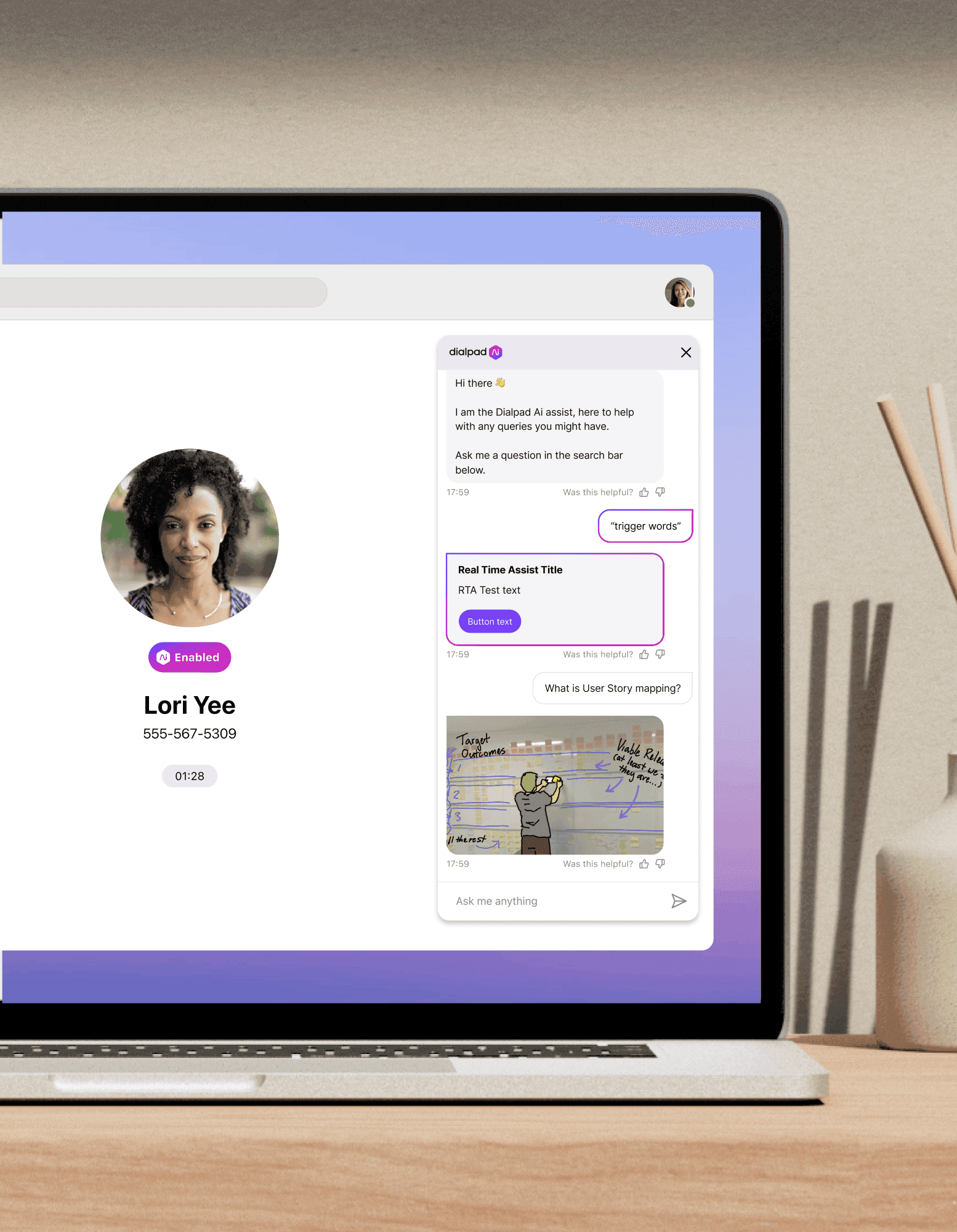
Once upon a time, the customer journey and how you deliver customer experience (CX) was a breeze.
Grab your audience’s attention with an enticing ad, meet them, and seal the deal at the company’s physical premises.
Today’s customer journey is far more digital—many organisations either have a digital transformation strategy or are working on one.
The new era of the digital customer experience comes with high customer expectations, so customer service teams must be at the top of their game to meet demand. Adding tech like Artificial Intelligence (AI) to the mix and adapting content and UX in real-time is not only possible, people expect it.
So, how can you become an authentic, customer-centric business that delivers a relevant, engaging, and seamless customer experience—every single time?
What is the digital customer experience?
The digital customer experience (often known as the DCX) includes every online touchpoint your audience has with your brand.
This means their mobile devices, computers, and tablets. Digital customer engagement platforms and channels like your website, email, SMS/MMS messaging, and social media all count as well.
The digital customer journey even considers digitally connected environments such as the Internet of Things (IoT) and voice-activated devices. In essence, wherever your customers engage with your brand online—it’s a digital experience.
The impact of digital transformation on customer experience (and vice versa)
Digital transformation and customer experience are closely intertwined.
Digital transformation enables businesses to offer new and improved digital methods for customer interactions, such as websites, mobile apps, social media, and chatbots. These digital touchpoints provide convenience, speed, and accessibility, enhancing the customer experience.
Customers can access information, make purchases, and interact with businesses anytime, anywhere, and on their preferred devices.
Focusing on delivering superior customer experiences through the digital channels they want to use can provide you with a competitive advantage. Prospects are more likely to choose your business over competitors if your team delivers an enjoyable and stress-free online customer experience.
Key elements of the digital customer experience
Mobile experience
With the exponential growth of smartphones and tablets, your customers increasingly expect seamless and user-friendly experiences on mobile devices.
Ensure your websites and apps are optimised to provide a smooth and intuitive experience. This includes considering responsive web design, fast load times, easy navigation, and mobile-friendly content and functionalities.
If your business is in ecommerce, offer convenient and secure mobile payment options. Think mobile wallets, mobile banking apps, and others. Streamline the checkout process for mobile devices to reduce friction and facilitate smooth transactions.
Personalising interactions
Everyone loves a personalised customer experience.
Extend personalisation across your various digital channels, including websites, mobile apps, email, social media, and chatbots. This ensures the customer experience is consistent across different touchpoints, providing a unified experience.
For example, customers who have added items to their basket on a website can receive a tailored reminder on their mobile app or via email. This approach can boost sales and help create a sense of loyalty towards your brand.
Successfully tailoring content and offering to meet people’s unique needs and preferences means you’re delivering the best digital customer experience. For example, you can leverage insights from Dialpad’s Ai Contact Centre analytics dashboard to make data-backed personalisation campaigns. Dialpad Ai can track how often certain topics or keywords come up in customer conversations, which you can then use to inform your product and marketing roadmaps:
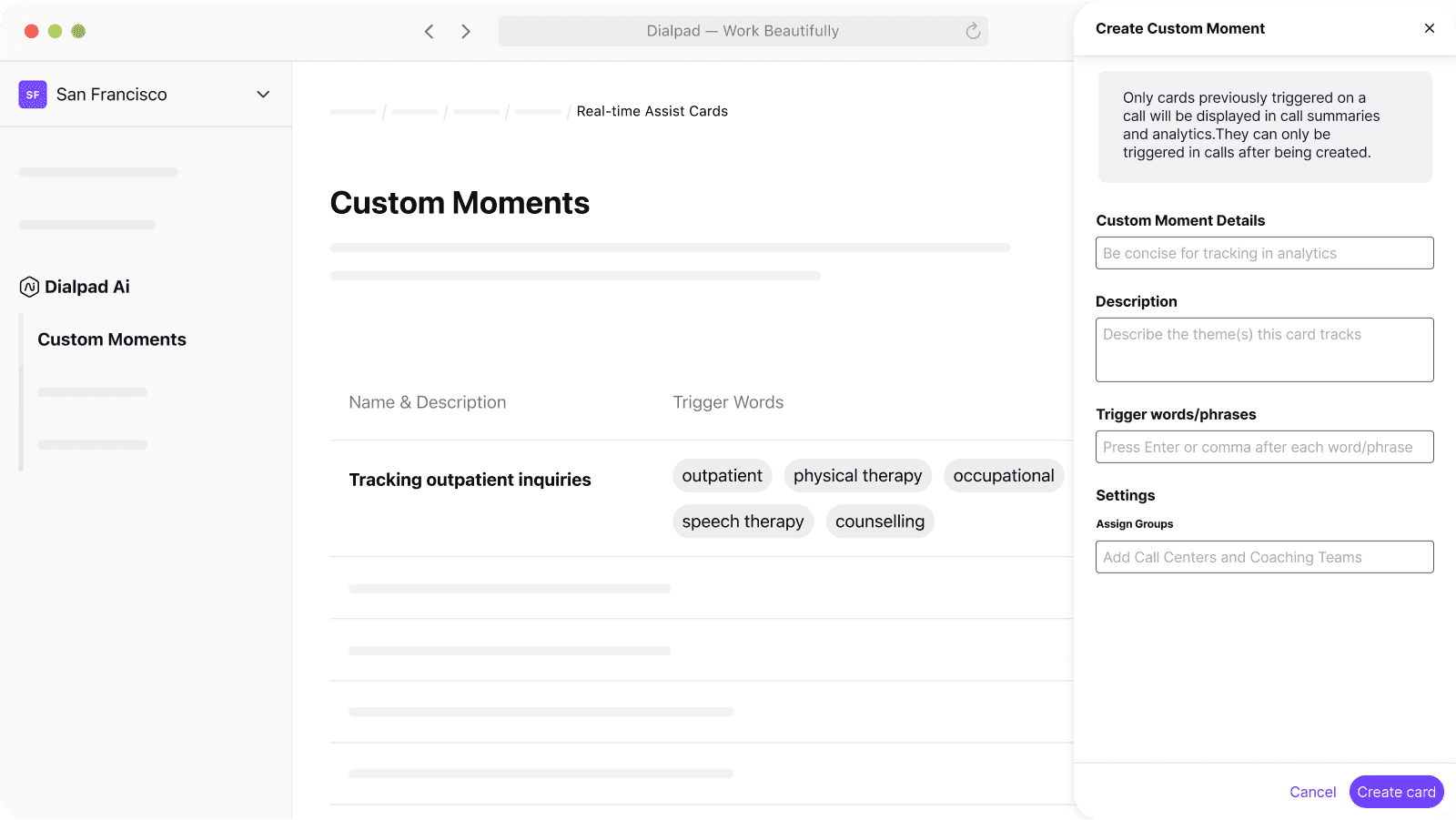
Making buying easy
A frictionless buying journey is a successful one. Making it easy for customers to buy your products or services is vital to the digital customer experience. To achieve this, offer various secure payment options, support via live chat, and a guest checkout to avoid customers leaving without buying.
Omnichannel communications
Another integral part of the digital customer experience is meeting your customers where they are.
Enabling communications via text, phone, live chat, email, and social media platforms offers your customers a wide variety of options to contact you. Offer channel flexibility and ensure that your digital and non-digital experiences complement each other.
To track communications with ease, use software and platforms that consolidate all these different conversations in one place—this way, your team can access past interactions and relevant information when responding to customers through different channels.
Ensuring customers can transition seamlessly between channels and devices and synchronising their data and preferences can improve your customer experience by making it both cohesive and personalised.
Enabling self-serve options
Many customers prefer to resolve issues on their own. Your business can provide a great digital customer experience by offering accessible self-service options.
Two essential components are providing an online knowledge base and FAQs for customer support, so customers can easily find answers to basic questions without contacting your team. Remember that you must cater to all customers, so a combination of both is essential.
For instance, customers who require assistance with a complex insurance claim may prefer to speak with a customer service team member on the phone. To mitigate this, having a solid Interactive Voice Response (IVR) system in place to route inbound calls and provide 24/7 service when agents are unavailable is critical:
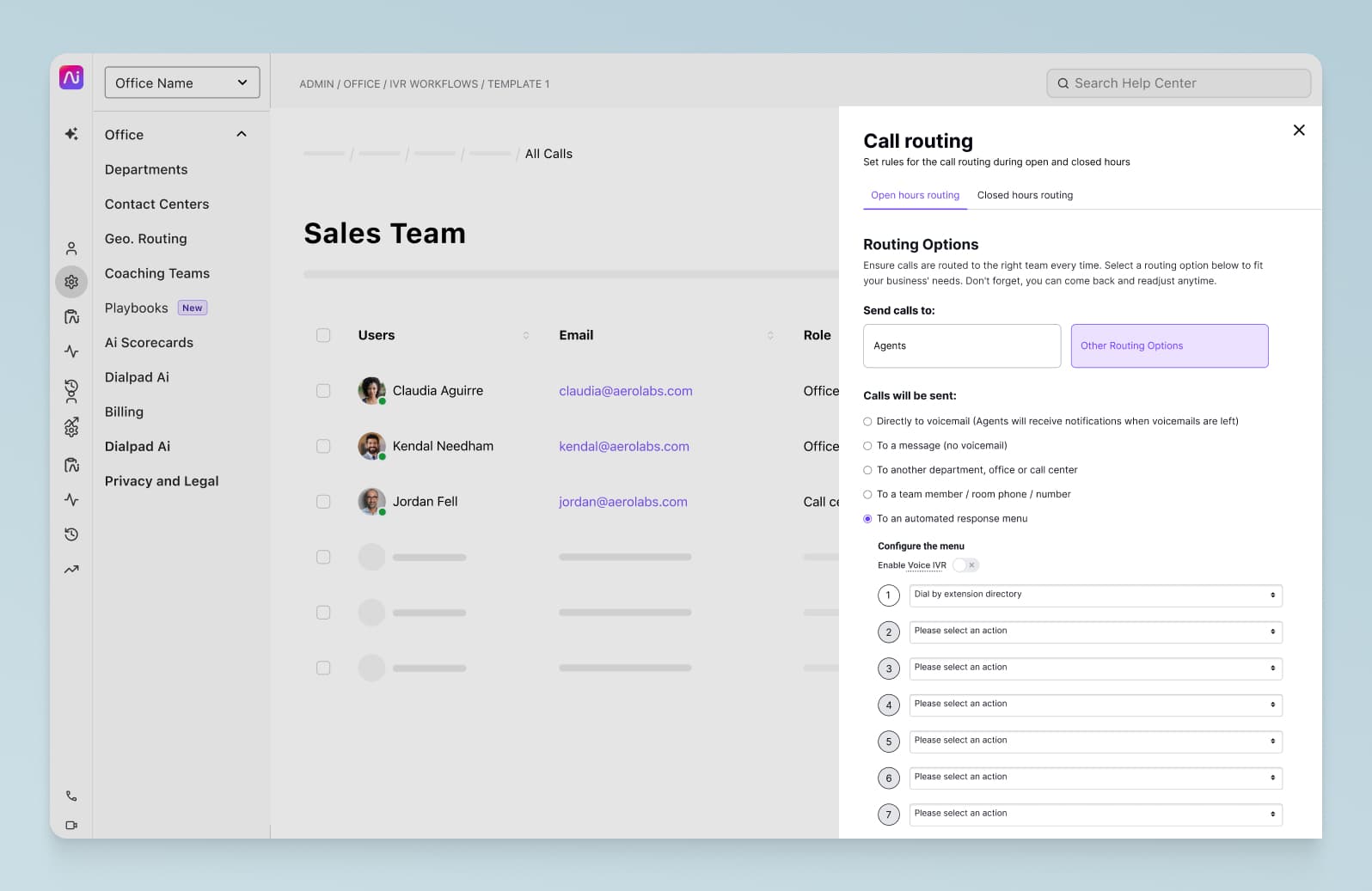
✨ How did these contact centres provide a good CX?
Grab the Contact Centre Playbook, which breaks down everything you need to know, from setup to staffing to optimising—with examples from real contact centre teams across different industries.
Customer service analytics-backed strategy
It’s crucial to understand which digital customer experience strategies are working and which aren’t.
That’s where customer experience analytics come in.
CX analytics involves collecting and evaluating customer data from various touchpoints, such as social media interactions, website feedback, and contact centre interactions. Comprehensive and easily accessible data is essential to providing an excellent digital experience.
Explore insights to identify areas for improvement. For example, it might be that your customers can’t find the information they need on your self-serve portal, leading to increased call volumes and lower overall customer satisfaction.
CX analytics can show you the specific pain points in this customer journey, such as outdated information, unclear navigation, and potential problems with the search functionality. These insights give you the confidence to make data-based customer journey decisions.
Digital customer experience trends to consider
Your DCX is ever-evolving. To constantly improve digital customer experience, keeping up with industry trends and new technologies is essential. Consider incorporating a combination of some of the following trends into your customer experience strategy:
Converesational AI or chatbots
When customers demand your attention 24/7, how do you meet demand?
According to Accenture, six in 10 executives said chatbots could improve their organisation’s ability to handle customer queries by networking with other bots. Moreover, they could deliver personalised attention to website visitors by being more conversational.
Chatbots are an affordable option to provide round-the-clock customer service and support and are likely to become increasingly common over time.
Real-time technology
Real-time tech is a significant trend for the transformative digital customer experience. It can encompass elements like data analytics, customer engagement, and sentiment analysis. Real-time tools allow businesses to quickly analyse customer interactions' sentiment to identify and address any issues or opportunities for improvement.
For example, Dialpad Ai offers real-time speech analytics, enabling companies and agents to analyse customer calls in real time. This tool delivers actionable insights while the customer is still on the other end of the line:
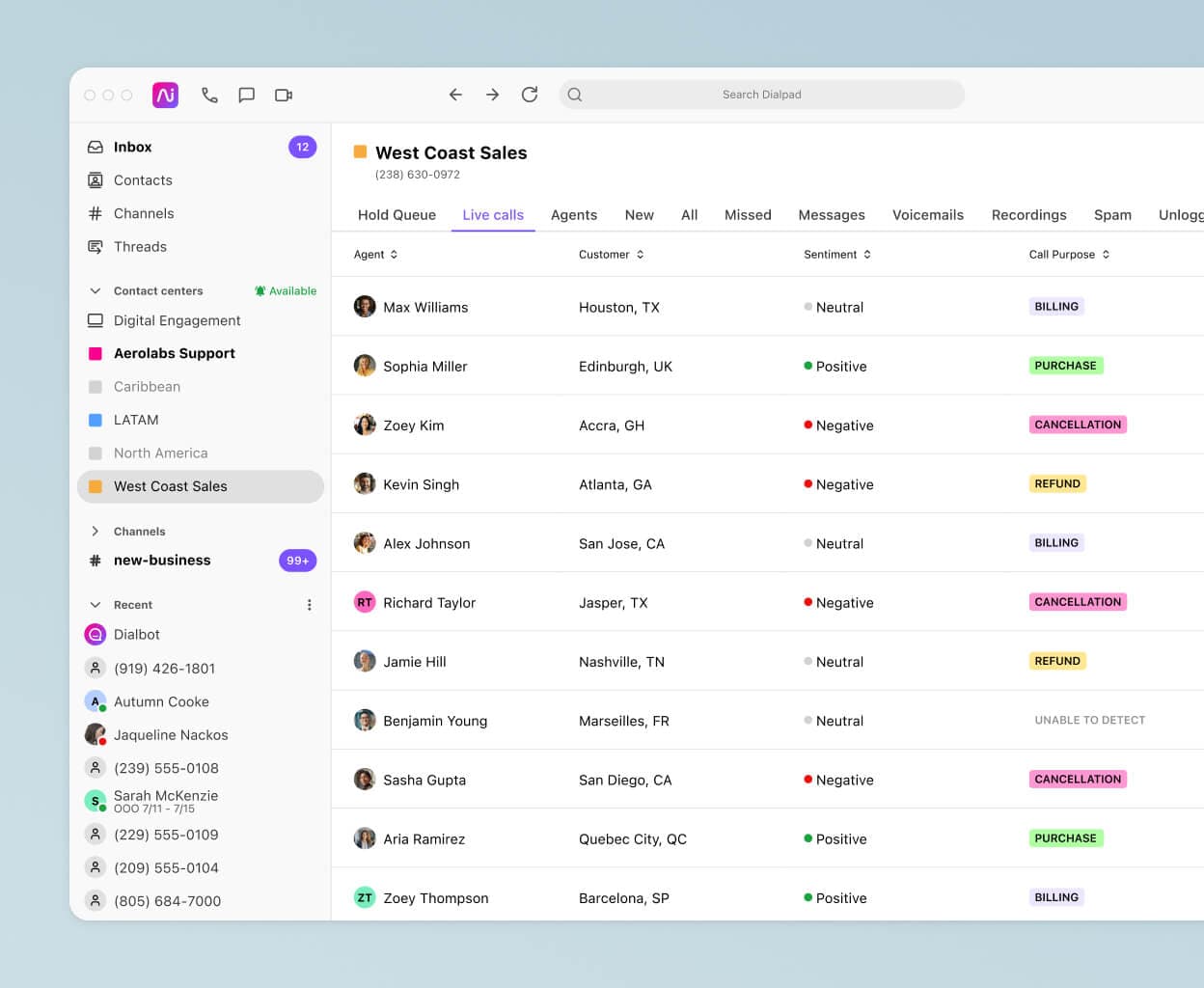
If an agent comes across a specific issue while providing customer support, they can access relevant information and guidance via an on-screen pop-up. This helps them address the customer’s needs faster, increasing digital customer engagement.
Increasing data security and privacy
As customer data becomes more valuable and regulations change, businesses must prioritise data security and privacy to build trust and maintain customer confidence.
This includes methods such as encryption, access controls, regular security audits, and data breach detection and response protocols. Investing in innovative cybersecurity technologies and practices can help prevent data breaches and protect customer information from unauthorised access.
Customers are increasingly concerned about how their data is collected, used, and shared by businesses, so it’s essential to provide transparent data collection and usage practices. To mitigate this, provide opt-in/opt-out options and be explicit about how their data is used to deliver personalised experiences.
Data-backed decision-making
Today, there is no longer an excuse to make important decisions based on "gut feeling" without any qualitative and quantitative data.
Whether you use customer service AI tools that uncover implicit feedback or predictive analytics tools that incorporate data, statistical algorithms, and machine learning techniques to analyse past customer behaviour and data patterns and predict future customer journey trends and preferences, businesses have more data at their fingertips than ever before.
This information is critical for identifying new customers to target, pinpointing potential risks, and improving your relationship with customers as they engage with your brand, products, and services.
How to assess your current digital customer experience: Metrics to track
Be sure to track the most relevant metrics to measure the performance and effectiveness of your digital customer experience efforts. Consider implementing customer engagement software to access the tools you need.
Here are some metrics you can deploy to assess your DCX:
Customer satisfaction (CSAT)
A CSAT score is a numerical measurement that helps businesses assess customer satisfaction with their product, service, or overall company performance.
It provides insights into customer happiness following a purchase or specific interaction and can help understand the existing customer journey to identify areas for improvement.
Typically obtained through customer satisfaction surveys, CSAT scores involve asking customers to rate their experience on a scale, such as 1-5 or 1-10, with higher scores indicating higher satisfaction. CSAT scores range from 0 to 100. They are usually calculated by taking the total number of customers who gave a positive rating, like a four or five, on a scale of 1-5, dividing it by the total number of survey responses, and multiplying it by 100 to get a percentage.
A CSAT score of 75 to 85% is generally considered good, but it's important to note that what's regarded as a good score can vary depending on your industry and business model.
Dialpad's cloud contact centre platform includes a built-in CSAT feature that allows businesses to create and deploy surveys in just a few seconds. These can be automatically played to customers after their calls to gather feedback on their satisfaction level.
You can customise your CSAT questions and allow your customers to provide more information about why they gave you that score. After you’ve gathered adequate data, you can explore your survey analytics by filtering different time periods, groups, and session duration to address any issues in the data.

Unfortunately, many customers don’t complete CSAT surveys.
Dialpad can help with this too. Its industry-first Ai CSAT feature to address this. As well as being able to analyse customer sentiment and transcribe calls in real time, Dialpad Ai can also infer accurate CSAT scores from all conversations, giving businesses a larger CSAT sample size and more accuracy when analysing how your customers feel about your brand:
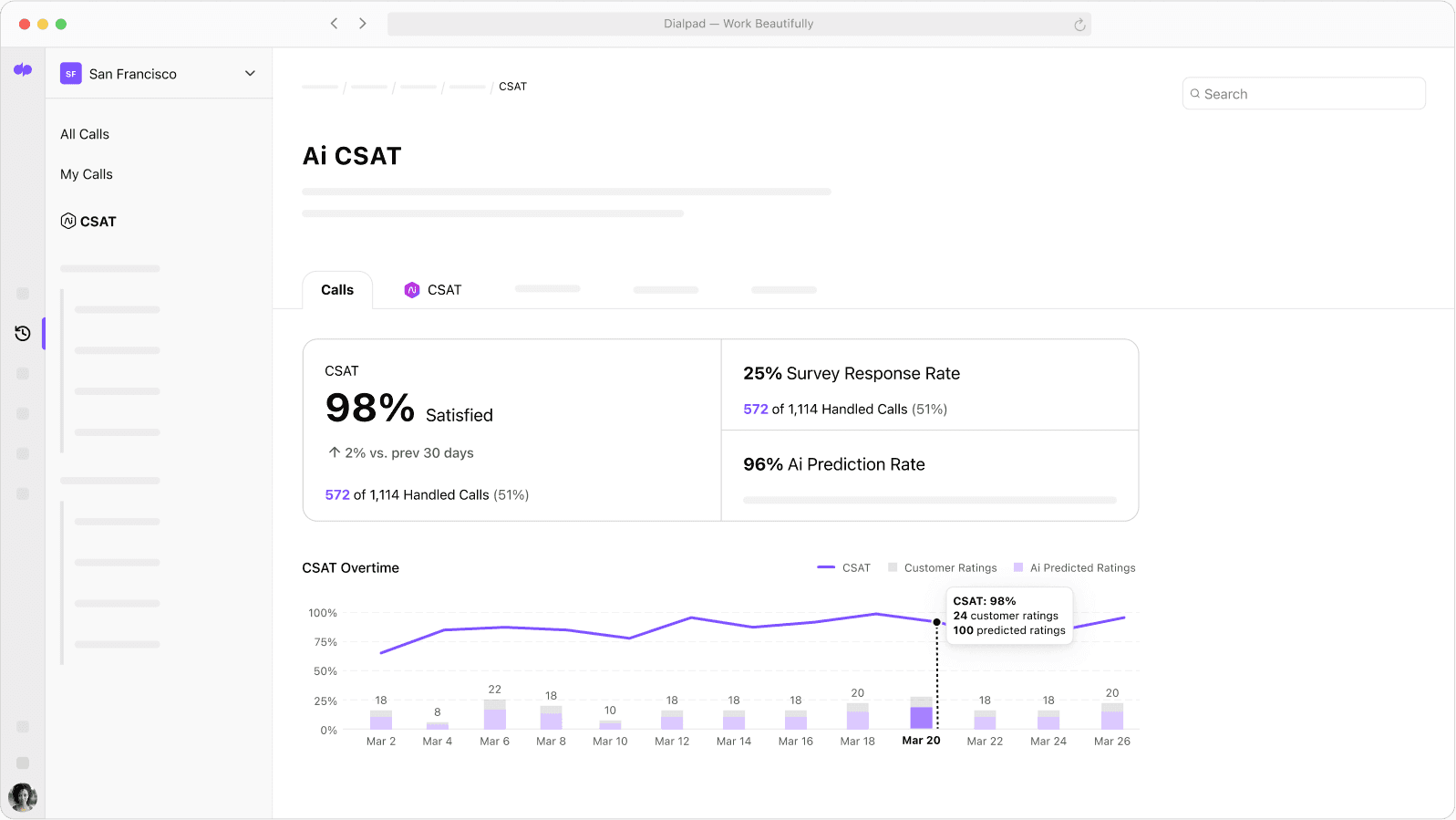
Net Promoter Score (NPS)
Similar to CSAT, an NPS can help measure customer loyalty and how likely they are to recommend your business to others. It’s calculated based on a single question: "On a scale of 0-10, how likely are you to recommend our business to a friend or colleague?"
An NPS can help you assess your customers' overall satisfaction with your digital customer experience, by means of how enthusiastic an advocate they are of your brand. NPS scores tell you whether your customers are:
Promoters: These are loyal and enthusiastic customers who actively promote your product or service to others. They typically give high scores of nine or 10 in surveys.
Passives: These customers are satisfied with your product or service but are not necessarily vocal advocates. They may give scores of seven or eight in surveys, indicating moderate satisfaction.
Detractors: Customers dissatisfied with your product or service and who may not recommend it to others. They may give scores ranging from zero to six in surveys, indicating low satisfaction or disappointment.
User engagement
Customer engagement metrics, such as time spent on site, number of pages visited, or frequency of visits, can help you understand how actively and deeply customers are engaging with your digital channels. Higher engagement typically indicates a positive digital customer experience.
Conversion rate
Conversion rate measures the percentage of users who complete a desired action on your digital platforms.
This could be buying something, filling out a form, or signing up for a newsletter. Monitoring conversion rates can help you assess your digital customer experience's effectiveness in driving desired customer behaviours.
Other customer support metrics
Metrics related to customer support, like average response time, resolution time, and first contact resolution rate, can provide insights into your digital customer support efforts. Monitoring these metrics can help you assess whether your digital customer support meets customer expectations.
Nailing your digital customer experience strategy: 4 best practices
Here are some digital customer experience best practices to keep in mind:
1. Define clear customer experience goals
Clearly defining your customer experience goals is vital to achieving them.
These goals must align with your overall business objectives. Identify what you want to accomplish with your digital customer experience strategy, whether it's improving customer satisfaction, increasing customer retention, or driving sales.
Set specific, measurable, achievable, relevant, and time-bound (SMART) goals that align with your company's vision and mission.
For example, if your business objective is to increase customer retention, your customer experience goals should focus on enhancing satisfaction, building loyalty, and delivering exceptional experiences.
Involve key stakeholders, such as cross-functional teams, leaders, and employees, in the goal-setting process. Seek input and feedback from different departments and levels of your organisation to ensure your customer experience goals are realistic, achievable, and meaningful.
This will help to create a shared understanding and ownership of the goals, which can help achieve them successfully.
Regularly review and analyse the data to learn how to measure digital customer experience efforts and identify areas for improvement. Adjust your approach as needed to ensure you are making progress towards your goals.
2. Understand your customers
Before creating a digital experience that your customers will love, it's crucial to know who your customers are.
Developing buyer personas can help you understand who’s buying your product and why. By creating detailed personas representing your target audience, you can tailor your digital customer experience strategy to meet their needs and desires.
Next, map out the customer journey. What do your website users do when they visit your website or app? What goals are they hoping to accomplish?
Think about these questions to identify the key touchpoints in their digital experience. Understanding their interactions and expectations at each journey stage can help you prioritise and optimise the most critical digital touchpoints to deliver a seamless and satisfying CX.
Once you clearly understand your target audience and their customer journey, use that knowledge to tailor your digital CX strategy. Tailor your content, messaging, and interactions to align with the specific needs of your customers.
By delivering relevant experiences that resonate with your target audience, you can enhance customer satisfaction, build customer loyalty, and drive customer retention.
3. Improve your user experience (UX)
A clunky user experience can make it unnecessarily challenging for customers to complete even the simplest tasks on your website or app.
When this happens, there’s an increase in reliance on your customer service team for assistance, resulting in a backlog of customer enquiries. That's why it's crucial to regularly revisit and optimise your site's or app's user experience.
To identify areas that need improvement, rely on your data. For instance, a particular landing page with a low conversion rate indicates a user experience issue. It could be messaging misalignment or sparse call-to-action buttons. Instead of relying solely on gut instincts, leverage the available data to make informed and effective UX improvements.
Enhancing the digital customer experience in this way can reduce contact centre volumes, increase customer satisfaction, and drive conversion rates and revenue growth.
4. Remain agile
Digital customer experience is a dynamic and ever-changing field. A future-proof digital experience strategy must embrace flexibility and acknowledge change as a constant factor.
Seek to ingrain this mindset into your leadership team and continue to reflect it in your company’s documentation, hiring decisions, technological investments, and implementation of ongoing improvements—rather than relying on large, one-time projects.
This proactive approach allows for agility and adaptability in response to changing customer needs, market trends, and technological advancements. Thus ensuring that your digital customer experience remains relevant and effective in the long run.
Be responsive to customer feedback and adjust your digital CX strategy accordingly. An agile approach will allow you to stay ahead of the competition and deliver a customer experience that exceeds expectations.
Stay customer-centric and create a digital customer experience that wows
The impact digital technology can have on your customer experience is phenomenal.
When you harness it correctly, your business has the power to be present on the channels your customers actually use, with the most relevant and personal messages that align with their needs.
Partner with a platform that enables you to achieve this easily, and you'll be able to provide an excellent digital customer experience.
Provide a better digital customer experience
From phone calls to live chat to emails, Dialpad Ai Contact Centre is designed to help you communicate better with your customers. Book a demo to see how it can work for your organisation, or take a self-guided interactive tour of the app on your own!
